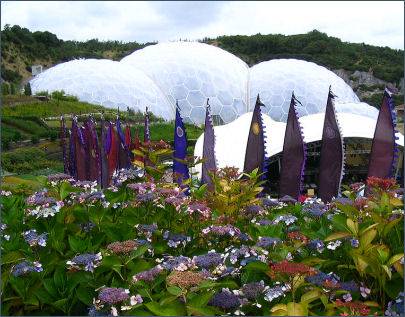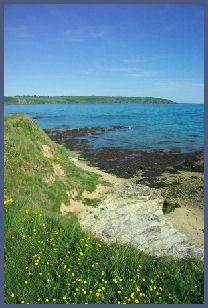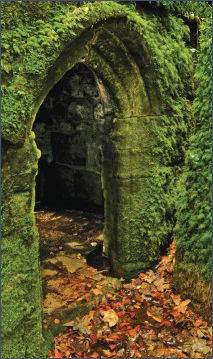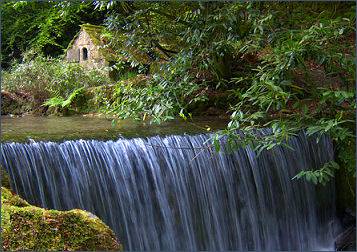OS Grid Ref:- SX011524
 A bustling market town at the heart of the Cornish 'mountains', St. Austell, known in Cornish Sen Ostell, boasts many interesting old buildings. The panoramic sweep of St. Austell Bay offers outstanding cliff scenery and some superb beaches.
A bustling market town at the heart of the Cornish 'mountains', St. Austell, known in Cornish Sen Ostell, boasts many interesting old buildings. The panoramic sweep of St. Austell Bay offers outstanding cliff scenery and some superb beaches.
St Austell is situated at the centre of the Cornish china-clay industry. The clay was discovered by William Cookworthy in 1755, with the opening of the pits to mine the clay, St. Austell's population and prosperity soon began to grow. The china clay industry was the mainstay of the area's economy and led to the transformation of St. Austell from a small Medieval village. The harbour was built and the local economy boomed until china clay slurry caused the silting which lead to St. Austell's closure as a port.
 St Austell's characterful narrow streets and pedestrianised precincts offer a wide range of shops. The highly interesting Wheal Martyn Heritage Museum covers the development of the china clay industry in the area and is well worth a visit.
St Austell's characterful narrow streets and pedestrianised precincts offer a wide range of shops. The highly interesting Wheal Martyn Heritage Museum covers the development of the china clay industry in the area and is well worth a visit.
Holy Trinity Church dates to the fifteenth century, unusual for Cornwall, the church's tower is finely decorated with sculptured figures.
The Polkyth Recreation Centre, near St. Austell Station offers squash, badminton, tennis, sauna, pool and has a cafe and bar and the Eden Project, one of England's most popular visitor attractions, is located nearby.
The picturesque port of Charlestown lies around 2 miles (3 km) to the south east of the town of St Austell. Charlestown was a Georgian 'new town' which developed from a small fishing village known as West Polmear.Charlestown has survived as a working port and a small amount of china clay is still exported. The port remains unspoiled and retains much of its Georgian character. Charlestown harbours a fleet of square riggers ships, there is generally at least one of these superb ships in the harbour.
Tregrehan Gardens Cornwall's dramatic temperate rainforest garden, was created in early nineteenth centry by Carlyon family, concentrating on plants from warm temperate regions. The beautiful woodland garden is situated at Par, which lies about a mile to the east of St Austell. Caerhays Castle Garden, near St. Austell, lies by the coast and surrounds an early nineteenth century Gothic Revival castle built by John Nash, the architect of London's marble arch. The gardens are justly famous for their spectacular Magnolias and wide range of shrubs. The gardens and castle are open to the public only in the spring.
Image 1 -copyright Patrick Charpiat, re-used under the Creative Commons Attribution-Share Alike 2.0 France license.
Menacuddle Holy Well
OS Grid reference- SX 013 535
 A magical and peaceful site which is well worth a visit, Menacuddle Holy Well lies near St. Austell and during the middle ages, was one of the most important religious sites in the whole of Cornwall.
A magical and peaceful site which is well worth a visit, Menacuddle Holy Well lies near St. Austell and during the middle ages, was one of the most important religious sites in the whole of Cornwall.
The curious name may derive from the late Cornish mena gothall meaning "hillside with a thicket" or from "mena" meaning a sanctuary and St Guidel - an unknown saint.
 The granite
wellhouse dates from the late fifteenth century, and was restored by Sir Charles Graves Sawle in 1922. A Gothic style archway leads inside, the walls and roof are covered in green lichen. Surrounded by trees and rhododendron bushes, a small waterfall on the river is situated in front of the wellhouse. The water is often milky white, as it is coloured by the local china clay.
The granite
wellhouse dates from the late fifteenth century, and was restored by Sir Charles Graves Sawle in 1922. A Gothic style archway leads inside, the walls and roof are covered in green lichen. Surrounded by trees and rhododendron bushes, a small waterfall on the river is situated in front of the wellhouse. The water is often milky white, as it is coloured by the local china clay.
The spring water was used in the past for its supposed curative powers. Sick children were taken to the well, it was also thought to be a cure for to ulcers. It was once thought to ensure good fortune, a crooked pin should be thrown into into the waters, nowadays coins are thrown instead, some visitors light candles in the well house.
Directions
The Well is not sign posted but is only a few minutes down the Bodmin Road from St.Austell. Take the track is on the left just after the Elderly People road sign. Follow this track where there is parking for a few cars.